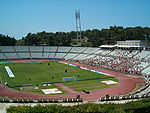Castro de Leceia

The Castro de Leceia or Leceia Eneolithic Station (Estação eneolítica de Leceia) is an archeological site of the Castro culture located in the Portuguese civil parish of Barcarena in the municipality of Oeiras. The area was first occupied during the end of the Neolithic (4th millennium BCE) and throughout the Chalcolithic, being abandoned somewhere between the end of the 4th and the beginning of the 3rd millennium BCE. The Castro was first dug and reported in 1878 by Carlos Ribeiro, who presented his results to the Lisbon Academy of Sciences in what may be considered the first monograph dedicated to a pre-historical Portuguese settlement. The last interventions date to 2003. The site is classified as a public interest monument (Imóvel de Interesse Público) since 1963.
Excerpt from the Wikipedia article Castro de Leceia (License: CC BY-SA 3.0, Authors, Images).Castro de Leceia
Rua 7 de Junho, Oeiras
Geographical coordinates (GPS) Address Website External links Nearby Places Show on map
Geographical coordinates (GPS)
| Latitude | Longitude |
|---|---|
| N 38.728055555556 ° | E -9.2816666666667 ° |
Address
Castro de Leceia (Povoado Pré-Histórico de Leceia, Estação Eneolítica de Leceia, Estação Arqueológica de Leceia;Povoado Fortificado de Leceia)
Rua 7 de Junho
2730-047 Oeiras
Portugal
Open on Google Maps






